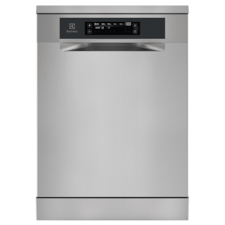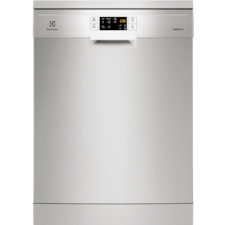A dishwasher is one of those home appliances that you never want to live without once you’ve used one. It’s extremely convenient and saves you time and money. However, many people never really get the best results out of their dishwasher because they either load it incorrectly, use the wrong program or make other mistakes in its operation.
To help people who may be new to dishwashers or want to figure out what they’re doing wrong, Electrolux Arabia's here to tell you how to use your dishwashing machine efficiently and avoid common mistakes.
So, follow us through the basic steps of using a dishwasher and look out for some of our tips and tricks that will help you get your dishes sparkling clean.
Step 1: Ensure that your dishwasher has salt and rinse aid
How to use dishwasher salt
If you’re using your dishwasher for the first time (or it has run out of salt), you will need to add dishwasher salt.
The purpose of dishwasher salt is to soften the water, since hard water with high lime content makes it harder for the detergent to dissolve when the machine is running. That means the salt makes your cleaning more efficient.
The salt is added at the bottom of the dishwasher. Remove the bottom rack and open the screw cap that covers the salt compartment. If you’re unsure of where to add salt in your dishwasher, check your user manual.
How much dishwasher salt to add is also a common concern. The correct way is to add salt until the compartment is completely full, then replace the screw cap and the bottom rack.
How to use rinse aid
Rinse aid helps avoid unsightly water stains or other residue on your dishes. It is usually added next to the detergent compartment. Open the rinse aid compartment’s lid and add rinse aid up to the fill line. Then close the lid.
Rinse aid has to be refilled much more often than salt, so make sure to keep an eye on your dishwasher’s rinse aid indicator. It will let you know when it needs a refill.
Step 2: Know how to properly load your dishwasher

How to put utensils (pots, pans, plates & large bowls) in dishwasher
The bottom rack of your dishwasher is usually the place where the strongest cleaning happens. The water jets here are designed to tackle heavily soiled pots and pans as well as plates, so make sure not to place lightly soiled plastic cups or Tupperware bowls here. They may deform.
Instead, use this large compartment to place your pots and pans, your plates and large bowls. Remember to place dishes in the dishwasher with the soiled surfaces facing down to ensure perfect cleaning.
As for plates, place them vertically in the rack. You don’t need to leave more free room between them than the rack allows, by the way. Don’t waste space by only putting plates in every other rack opening.
How to load cutlery in dishwasher
If your dishwasher has a basket for cutlery in the bottom rack, place your cutlery in it, with the handles facing down. However, you may want to place sharp knives in the basket with the blades facing down to avoid injury.
Alternatively, place knives and other long utensils between your cups and bowls in the top rack, with the blades facing down. If your dishwasher has an extra cutlery rack at the top of the appliance, place cutlery in it with any sharp blades facing down.
How to put cups, glasses, and small bowls in dishwasher

In the top rack, place glasses and cups with their bottoms up to allow the water jets to spray the inside of glasses without water getting collected in them. There is also usually room in the center to place small bowls or saucers that are too small for the bottom rack.
A question that often comes up in this context is: can you put ceramic mugs in the dishwasher? The answer is yes. Because they’re glazed, they’re usually dishwasher-safe. However, be cautious with mugs that are hand-painted. The dishwasher may wash off the paint, so it may be a better idea to clean hand-painted mugs by hand.
Before you close your dishwasher after loading it, make sure that the water sprayer arms aren’t obstructed by any dishes.
>>> Related post: Dishwasher benefits
Step 3: Add dishwasher detergent
Dishwasher detergent comes in many different forms, from liquid and gel to powder to tablets and packs. Which form of detergent you want to use is up to you, just ensure that you know how to use the correct amount.
Using the correct amount is generally easier with tablets and packs. You just use one of them.
With other detergents, follow the instructions on the package as well as in your dishwasher’s manual. Using powder dishwasher detergent, liquid or gel dishwasher detergent, you usually fill up the detergent compartment to the fill line.
If your dishwasher has a pre-wash compartment, you may use it for particularly heavily soiled loads. Add detergent to the pre-wash compartment to make your dishwasher’s pre-wash cycle gives a stronger start to your cleaning.
Always make sure to use detergent that is designed for use in dishwashers. Never use normal dishwashing soap in your dishwasher.
Check out our tips on how to choose a dishwasher.
Step 4: Choose the correct dishwasher program

A big part of knowing how to use dishwasher machine correctly is choosing the best program for your dishes.
Depending on the manufacturer, dishwashers may offer different programs, but almost all share three basic cycles:
- Quick cycle: uses higher temperatures and more water to clean lightly soiled dishes more quickly.
- Intensive cycle: is best used for heavily soiled pots and pans.
- Normal cycle: can be used for your everyday cleaning. Unless you need your dishes cleaned extra quickly or they’re extra dirty, we recommend that you opt for the Normal cycle to save water and electricity.
Electrolux dishwashers also offer an Eco program that helps you save more water and energy with extra-efficient cleaning. Some Electrolux dishwashers also have an Extra Hygiene function that kills off 99.99% of bacteria and viruses.
Check out below our full collection of dishwashers, from freestanding models to semi-integrated and fully-integrated dishwashers:
- MaxiFlex drawer space can be adapted to the load.
- SoftGrips and SoftSpikes delicately hold glasses.
- SatelliteClean reaches all items with water jets.
- QuickSelect removes the guesswork of dishwashing.
- MaxiFlex drawer space can be adapted to the load.
- SatelliteClean reaches all items with water jets.
- SatelliteClean reaches all items with water jets.
- AirDry for 3x better drying performance*.
- MyFavourite remembers your favourite cycle.
- AirDry for 3x better drying performance*.
- Delay start of the program to suit your schedule.
- FlexiShelves keep your cups safe in the wash.
- AirDry technology uses natural airflow to finish its drying cycle.
- AutoFlex programme with smart sensor adjusts the consumption of each dishwashing cycle
- Delay Start function, you can load it when you want
- MaxiFlex drawer space can be adapted to the load.
- SatelliteClean reaches all items with water jets.
- AutoFlex adjusts the wash cycle to each load.
5 hacks to get the most out of your dishwashing machine
1. Place plates facing inwards
Something you need to remember about how a dishwasher works is that the water sprays from the center of the machine outward. Due to the spinning action of the sprayer arms, it doesn’t shoot up exactly vertically.
That’s why it’s a good idea to let the most heavily soiled parts of dishes, such as the tops of plates, face the water spray directly. The same goes for pans or cutting boards.
2. Put small plastic items in a laundry bag
If you’ve ever tried to clean small plastic items in a dishwasher, you’ll know that the water spray is just too strong for such light items. They’ll go flying and you’ll end up picking them up from the bottom of the dishwasher.
To combat this problem, use a mesh laundry bag that is used to wash delicates in your washing machine and place the items inside before putting them in the dishwasher. They’ll get squeaky clean and remain in the same place.
>>> Suggested post: How to operate an automatic washing machine
3. Keep it clean
While your dishwasher is self-cleaning to a point, you still need to give it a bit of a cleaning sometimes. Grime can build up after many cycles, and it may affect your cleaning performance.
4. Unload the bottom rack first
When your dishwasher cycle is done and you’re unloading, take out the dishes from the bottom rack first. Items in the top rack may have turned over during cleaning and may have water pooled in them. If you unload the bottom rack first, you avoid spilling that water all over your clean dishes underneath.
5. Don’t run your dishwasher when it’s half full
Sure, you may need those dishes back as soon as possible, but try to avoid running your dishwasher when it’s not full. This can end up costing you more in electricity and water bills while at the same time causing a negative impact on the environment and reducing the lifespan of your appliance.
Check out some tips on how to use your kitchen appliances:
Welcome to a cleaner life
Having a dishwashing machine will make your life so much easier, you won’t believe you ever did without it. And if you follow our tips on how to use your dishwasher efficiently, you’ll be saving water and money as well as time.
With our Electrolux dishwashers, you can even set your washing cycle after your own schedule, making sure that you always come home to perfectly cleaned dishes, so be sure to check them out today. Our products ensure that less energy is used for a more sustainable way of drying dishes.
Find out more about our Better living program to understand our efforts to shape better and more sustainable living around the world.
FAQ about how to use a dishwashing machine
-
Can you use liquid dish soap in the dishwasher?
No. Never use normal dishwashing soap in your dishwasher. Always use detergent that is designed for use in dishwashers.
-
How to use liquid dishwasher detergent?
With liquid or gel dishwasher detergent, you will need to fill up the detergent compartment to the fill line. Also, make sure to follow the instructions on the package as well as in your dishwasher’s manual.
-
How many litres does a dishwasher use per load?
Electrolux has a range of AAA-rated dishwashers that use only 10 litres of water for each full load with no loss in performance. Many of our energy-efficient dishwashing machine also have an auto-off feature, which automatically disconnects your dishwasher from the main electricity 10 minutes after the cycle has finished to save you energy and water at home.
-
How long do dishwashers generally last?
Many dishwashers last 10 years depending on how often it's used. With proper maintenance, dishwashers can even last up to 20 years.
-
How wide is a dishwasher?
The standard size of a dishwasher is typically 60 cm wide, 60 cm deep, and 80 – 85 cm tall. However, these dimensions can vary depending on the brand and model.















